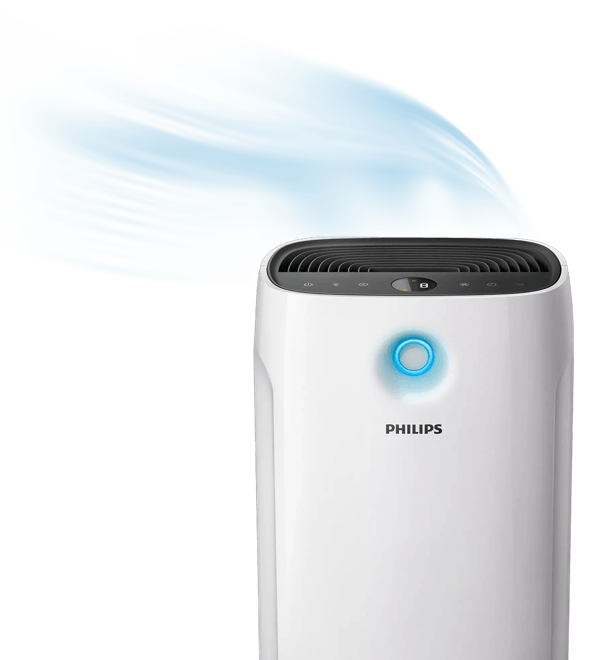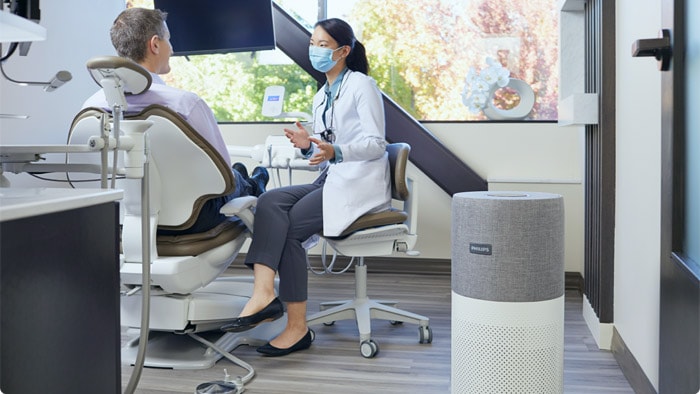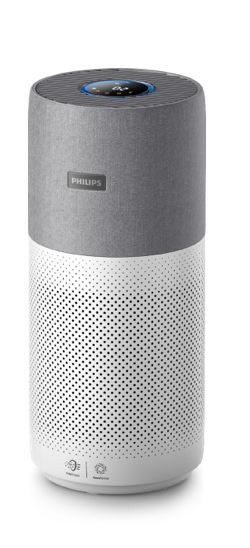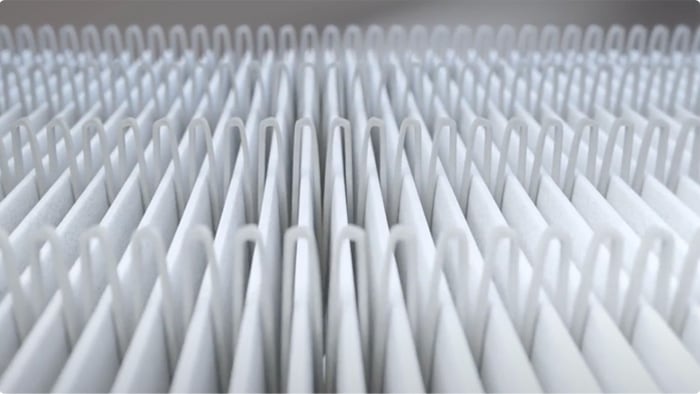Find your product
Safer, healthier indoor air
Eliminates 99.97% of indoor pollutants, including allergens, for healthier indoor spaces*


For large orders or special requirements
please contact:

*Patricle-CADR is tested by third party lab according GB/T8801-2015 **Room size is calculated according to NRCC-5401, using cigarette smoke CADR tested according to GB/T8801-2015 ***Room size is calculated according to GB/T8801-2015, using cigarette smoke CADR tested according to GB/T8801-2015
Impact
Let’s get back to work
Air quality awareness has increased since the pandemic but did you know that indoor air can be 2 to 5 times more polluted than the air outside? With a Philips air purifier you can get back to work while providing clean air to your students, staff and customers.
Business in:
How Philips Air Purifiers can help your business

CADR
What CADR means for your home
The Clean Air Delivery Rate is the global standard for measuring how much air (m3) a purifier can clean in a certain amount of time. So, the higher the CADR, the faster the purification. Airflow only measures wind speed, so it only tells us how much air is coming out. What airflow does not tell us is how clean that air is. This is why CADR is the right metric to use when choosing your purifier.
With air purifier of CADR 500
With air purifier of CADR 100
With no purifier


Best in test
Best Air Purifier according to Stiftung Warentest
The AC2889/10 performs best in German Stiwa Tests because we engineer and optimize our products for high CADR.

Discreet
Quiet, so you can focus on your work
In sleep mode, the air purifier operates in near silence so you can concentrate on your work.

Low maintenance
Easy to
replace filters
Philips air purifiers display a message when the filter needs to be changed. It’s quick and easy, and they last up to 3 years.
Disclaimer: Service life is based on a theoretical calculation of the average annual regional values of harmful outdoor air particles and daily use of the air purifier for 16 hours in automatic mode.

Operating modes
Choose your setting
Philips air purifiers have a number of speed settings to fit your specific setup or needs. Also, they use the same amount of energy as a standard light-bulb, so you can use them 24/7.
Research
Science and innovation
With a team of more than 100 scientists, doctors and engineers working in air purification, Philips has a long-standing heritage in health tech and has become one of the global leaders in air purifiers.
*Source: Euromonitor International Ltd; Consumer Appliances 2020 ed; “leading” defined as top 10 brands by volume sales; 2019 data.
How the purifier works
The allergy expert
Independently
tested and certified

European Center for Allergy Research Foundation
Certified allergy-friendly. Philips air purifiers fit the needs of allergy sufferers.

IUTA research institute
Tested for 99.97% filtration of nano-particles, at 0.003 microns.
Support
How can we help you?
- How do Philips air purifiers work?
-
An air purifier creates a circulation of the room air (combination of motor and fan), detects PM2.5 and reacts to the contaminants in the air and filters the contaminated air through a filter system that traps fine dust, allergens, viruses, bacteria, harmful gases, etc. . This cycle of operation is repeated as the room air is recirculated by the air flow from the air purifier; therefore it is very important that the air purifier has a high airflow to keep the air clean.
- What does CADR mean?
-
CADR - Clean Air Delivery Rate is the amount of clean air in cubic meters per hour that we measure as a combination of air flow and filter efficiency. CADR helps you understand how quickly an air purifier can clean a room. A higher CADR in a room can lead to faster cleaning and thus to a lower concentration of pollutants in the air.
- What is a NanoProtect HEPA filter and its advantages?
-
HEPA (High-Efficiency Particulate Air) filters consist of a mat made of randomly arranged fibers. HEPA filters are designed to target a range of particle sizes. These particles are captured and stacked on top of the fiber. Philips air purifiers use NanoProtect HEPA filters. These filters provide 99.97% particle separation at 0.3 µm (0.3 µm being the estimated particle size with the greatest penetration for NanoProtect HEPA). NanoProtect HEPA uses a combination of mechanical and electrostatic filtering, whereby the larger particles are captured by mechanical action and the smaller particles are captured by electrostatic action. This filter design enables optimal size, better air circulation, higher speed of air purification.
- What is the relationship between 99.97% and the 0.003nm (nanometer)?
-
99.97% is usually associated with 0.3 μm as the common filter specification, which is the HEPA requirement specified by global standards. Philips air purifiers show an efficiency of 99.97% for even smaller particles. Our products are tested to 0.003 μm, the smallest particle available that has high efficiency at 99.97% filtration.
- Why is it important that the air purifiers are optimized in favor of a high CADR?
-
Philips air purifiers are designed to provide best-in-class air cleaning performance for everyday, real-world consumer situations. They are intended for indoor use with high activity, e.g. In kitchens and living rooms at home, in schools, in classrooms, in the workplace, in restaurants, in retail stores, etc. For optimal performance, an air purifier must provide a high rate of air purification (as measured by CADR according to industry standards). At Philips, we optimize our products to achieve a higher CADR with the aim of increasing protection against dangerous small particles, allergens and aerosols containing viruses. CADR stands for Clean Air Delivery Rate and is a direct function of filter efficiency and air flow.
The filter efficiency is measured as the fraction of particle separation at a certain particle size. At Philips, we measure filter efficiency down to 0.3 µm (estimated most difficult particle size) and down to 0.003 µm (smallest measurable particle size). Air flow is measured by the flow of air through the filter and is maximized when the resistance to air flow through the filter is less.
- Does the Philips NanoProtect HEPA filter meet the HEPA 13 or HEPA 14 standards?
-
HEPA-13 / H13 is a well-known industry standard for air filters that follow the EU standard EN1822. Certified HEPA-13 filters guarantee 99.95% air purification of the most difficult particles to filter (MPPS, according to the European standard). MPPS stands for “most penetrating particle size”, in other words, this is the most difficult particle size to filter in any filter (not necessarily the smallest particle size). However, the HEPA-13 standard has some important limitations. One of them is that it does not take into account the air purification rate (measured by CADR according to industry standards), which is arguably much more important in everyday, real-world consumer situations.
The NanoProtect HEPA filters from Philips offer a filter efficiency of 99.97% at 0.3 µm. The faster the air cleaning rate (CADR), the better the protection against dangerous small particles, allergens and aerosols from viruses. On this basis, it is expected that NanoProtect HEPA filters will do a better job in everyday, real consumer situations than conventional HEPA-13 certified filters. They clean the air faster with a more optimal size, lower energy consumption and lower material costs and thus lower the total cost of ownership for our consumers.
- Can Philips air purifiers be used outside the home?
-
Philips air purifiers are designed and manufactured in compliance with all safety regulations and standards (IEC / EN 60335-1 IEC / EN 60335-2-65). They can be safely used in a wide variety of indoor spaces, such as: B. in homes, offices, schools or dental clinics. For optimal use, please read the user manual for each product.
- How do I dispose of the Philips filter?
-
We recommend placing the filter in a disposable bag and following normal practice, then washing your hands for at least 20 seconds and following advice from local health authorities on how to deal with potentially infected surfaces.
We also recommend washing your hands for 20 seconds when cleaning the filter.
- Can Philips air purifiers run continuously?
-
Philips products are rigorously tested before they hit the market. Philips carries out lifespan and durability tests. The performance of Philips air purifiers has been tested and validated for continuous indoor use for a period of three years.
The durability of the filter in Philips air purifiers depends on the environment in which it is used. For optimal performance, the Philips NanoProtect HEPA filter should be replaced as soon as the user receives the message to change the filter via the device or the Clean Home + app (for Philips air purifiers with app control). For more information, please refer to the user manual and warranty card. If you have any further questions, please contact Philips Customer Care.
Get support for your
Air Purifier
Air Purifier

Get support for this product









